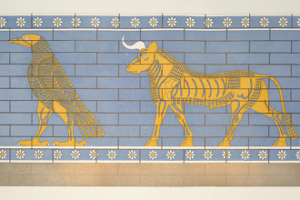
Arquivo para June 12th, 2024
The forgotten language of the Akkadians
Many narratives from the past were engraved on the walls, such as the famous Rosetta stone, it helped to spread the Syrian language, the Bible and its students (exegetists are a small part of the most orthodox interpreters of the Bible) we preserved Aramaic and ancient Hebrew, After a century of study, several researchers, including Irish researcher Martin Worthington, helped discover a mural of several found in excavations in the city of Dūr-Šarrukīn, in ancient Assyria and in present-day Iraq.
the walls, such as the famous Rosetta stone, it helped to spread the Syrian language, the Bible and its students (exegetists are a small part of the most orthodox interpreters of the Bible) we preserved Aramaic and ancient Hebrew, After a century of study, several researchers, including Irish researcher Martin Worthington, helped discover a mural of several found in excavations in the city of Dūr-Šarrukīn, in ancient Assyria and in present-day Iraq.
Historians identified a pattern on the wall repeated by a lion, a bird, a bull, a tree and a plow, but its meaning remained unknown.
Focusing on these studies, the professor at the School of Languages, Literatures and Cultural Studies at Trinity College, in Dublin, states that the images on our walls represent the name of King Sargon II and the constellations reinforce his imperial power at the time, with two first great western empires.
The Assyrian words two five symbols placed in the correct order would function as a sound that would give rise to the name “Sargon” (šargīnu), and would thus mean the power to stop King Sargon II and the historical period has great significance for much for the origin of Arab ancient cultures, such as Semitic and Akkadian, we have already posted here the Semitic extension and whose particularity with the Hebrews gave rise to the contemporary name of Semitic origin, but the Akkadians are not confused with this ancient origin.
They formed the first large centralized empire in the region, they predate the Babylonian period and hence their historical importance, the Semites were a distinct and educated people and did not mix with the numerous Semitic group of the time (Islamic, Jewish and Christian descended from this line). and the Akkadian empire dominated them for 180 years.
The name Semitic comes from Shem, son of Noah (the guy who built the ark) while the Akkadians remain unknown on this origin, but the mural is certainly Akkadian.
The mural also represents specific constellations, some familiar ones such as the constellations of Leo and Taurus, the bird represents Aquila, a constellation in the northern hemisphere, the plow would be named after an ancient Babylonian constellation, epinnu, today known as part of Andromeda and the Triangle Boreal.
The most controversial interpretation defended by Worthington argues that the tree in the Akkadian pronunciation is isu, similar to that of isu, the ancient constellation of the Jaw and thus would complete his analysis giving rise to the name of king Sargon II (šargīnu), Worthington is also known for helping in the current scripts for Marvel’s Eternals and Godzilla II: King of the Monsters and this makes it possible to understand his personality and taste for old narrations a little better.
“The effect of the five symbols was to place Sargon’s name in the heavens for all eternity – a clever way of making the king’s name immortal. And, of course, the idea of extravagant individuals writing their names on buildings is not unique to ancient Assyria,” says Worthington, so in Akkadian fashion the king devised a way to write on walls throughout the kingdom: “Sargon was here” and perpetuated his name in history, emperors and dictators always thought they were gods.

